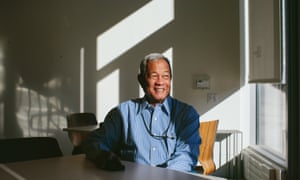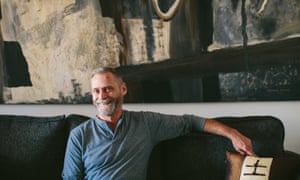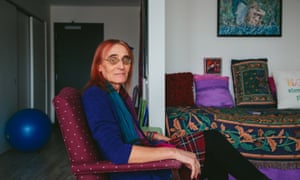http://www.theguardian.com/world/2015/dec/01/chicago-first-lgbt-retirement-center-here-people-would-come-to-my-aid
Tuesday 1 December 2015 14.00 GMT
Last modified on Tuesday 1 December 201514.23 GMT by Zach Stafford in Chicago

George Garcia, in a common room where coffee is served every morning. Photograph: Alyssa Schukar for the Guardian
As we enter the adjoining Town Hall apartments, a low-income senior residential building primarily for LGBT people that opened along with the center, we run into a fellow resident named Kurt Simmons, 63, a fifth-generation resident ofChicago. After a brief introduction, Simmons offers a private tour of his apartment.
Walking through the 79-unit residential building that sits on the main drag of the historically gay neighborhood of Boystown, Simmons warns that his space isn’t as clean as usual, but when we enter it bears no sign of mess. A large sofa sits in his living room with paintings adorning the wall and light dances through his Lake Michigan-facing windows.
Asked what it’s like living in what many in the area have affectionately dubbed the “gay senior dorm”, he and Garcia laugh. “I don’t’ think of it as a dorm,” Simmons said. “It’s not really just a room to me … it’s much more.”
The rising rainbow tide
In the US, many organizations are preparing for what has been dubbed the “silver tsunami”, referring to the the ageing of the Baby Boom generation. As a result, senior-living and affordable-housing sectors face a large influx of people in need, creating strain on these services.
And within this tsunami, a rainbow has emerged: a realization that to be both LGBT and elderly is to be potentially more vulnerable to health barriers, isolation and homelessness compared with non-LGBT elders. In response culturally sensitive facilities, like the Town Hall apartments in Chicago, are opening.
LGBT people over the age 55 are 83 times more likely be to be closeted, according to a 2010 report by the Williams Institute at the University of California, Los Angeles. For many, their neighbors become particularly important in their last years.
“I haven’t been hospitalized since 2007, but here I seem to always be going [to attend to friends],” Garcia told the Guardian. “I’ve been to the hospital over nine times just this year! And for everyone I brought to the emergency room there’s no family, just me.”

Kurt Simmons poses for a portrait in his living room. Photograph: Alyssa Schukar for the Guardian
While Garcia has become one of the go-to people in the building when emergencies arise, he says it’s not just because of family rejection, but because he and others are constantly checking in on each other.
Advertisement
According to the 2011 Aging and Health report from the Institute for Multigenerational Health in Seattle, Garcia’s vigilance is appropriate because nearly one-half of LGBT elderly have a disability.
“There’s different ailments for people in the building,” Garcia, who is openly HIV-positive, continued. “I know there’s at least eight people who are HIV-positive.”
“A good friend of mine was complaining and didn’t come down for lunch,” Garcia said, recalling a recent visit to the emergency room with a fellow resident who told him she was having stomach pains. “So I texted her: how long have you been hurting?”
The resident had been in pain for almost a day, and Garcia, having gone through a similar situation, jumped into action. “Girl, you better come down here,” he remembers telling the neighbor over the phone. “Let’s go to the ER.”
When admitted, the doctors found that her appendix was about to burst and she needed it removed. She arrived not a moment too soon.
‘Here, people would come to my aid’
However, even with health and mortality being regular conversations throughout the building, living remains the primary focus. Because for many, being at Town Hall feels like it’s just the beginning for them.
“I’ve always wanted to move to rainbow land,” Eva Skye, 64, said as she walked about her apartment filled with artwork. “[Boystown] is the safest place for me. But I couldn’t afford it before this place came along,” Skye continued.

From left, Ted Swanson, Glenn Charlton and Kurt Simmons enjoy coffee in a common room. Photograph: Alyssa Schukar for the Guardian
Over recent decades, the area in which Town Hall sits has become one of the most expensive places in Chicago. And rising rents have slowly forced many people who’ve lived there for years to move out. The growing costs have served as a barrier for people like Skye, who earns below poverty line wages.
Skye, who was born and raised in Chicago, has always found herself longing for a home within the area, and became especially desperate to move there once she began transitioning in 2008.
Before moving to Town Hall, she lived only a few miles north in the Uptown neighborhood in a single-room occupancy (SRO) building where she says she felt unsafe. “Living at an SRO is tricky for anyone,” Skye said. “But if you’re trans-queer … it’s real tricky.”
Skye remembers her old building as “cold” and “dark”, recalling the rude remarks about her gender presentation that were thrown at her. Town Hall, in contrast, is flooded with natural light – and she refers to the residents as her “rainbow family”.
“If I was attacked here, people would come to my aid,” Skye said, her eyes growing teary. The violence that transgender women like her face is one that has reached epidemic levels according to activist and anti-violence groups, which have called 2015 the most violent year for transgender women on record, with at least 21 murders.
As Skye looks out of her window, down to the Boystown neighborhood that bustles along as buses and cars and people go about their day, she takes a breath.
“And that’s just mind-boggling.”
Eva Skye poses for a portrait in her living room at the Town Hall apartments in Chicago. Photograph: Alyssa Schukar for the Guardian
A soft morning light dances through the windows of one of the country’s only LGBT senior centers as George Garcia, 64, smiles and stares off, briefly letting a sweet memory rush forward.
Garcia, one of the largely invisible estimated 1.5 million LGBT seniors in the US, begins telling a story about the closeted police officer he came to know decades ago, at the same place where we are now sitting.
“We never really decided if it was a relationship,” he says. “I guess it was maybe one of those things that was more of a friend with benefits.”
Before it became the Center on Addison, Chicago’s first LGBT senior center, the building was a police station. Garcia worked there part-time for a few months while between jobs, casually dating a closeted officer who got him the job typing police reports.
Garcia takes me through the now modernized building that opened last year – a space he says is unrecognizable in its beauty.
A soft morning light dances through the windows of one of the country’s only LGBT senior centers as George Garcia, 64, smiles and stares off, briefly letting a sweet memory rush forward.
Garcia, one of the largely invisible estimated 1.5 million LGBT seniors in the US, begins telling a story about the closeted police officer he came to know decades ago, at the same place where we are now sitting.
“We never really decided if it was a relationship,” he says. “I guess it was maybe one of those things that was more of a friend with benefits.”
Before it became the Center on Addison, Chicago’s first LGBT senior center, the building was a police station. Garcia worked there part-time for a few months while between jobs, casually dating a closeted officer who got him the job typing police reports.
Garcia takes me through the now modernized building that opened last year – a space he says is unrecognizable in its beauty.

George Garcia, in a common room where coffee is served every morning. Photograph: Alyssa Schukar for the Guardian
As we enter the adjoining Town Hall apartments, a low-income senior residential building primarily for LGBT people that opened along with the center, we run into a fellow resident named Kurt Simmons, 63, a fifth-generation resident ofChicago. After a brief introduction, Simmons offers a private tour of his apartment.
Walking through the 79-unit residential building that sits on the main drag of the historically gay neighborhood of Boystown, Simmons warns that his space isn’t as clean as usual, but when we enter it bears no sign of mess. A large sofa sits in his living room with paintings adorning the wall and light dances through his Lake Michigan-facing windows.
Asked what it’s like living in what many in the area have affectionately dubbed the “gay senior dorm”, he and Garcia laugh. “I don’t’ think of it as a dorm,” Simmons said. “It’s not really just a room to me … it’s much more.”
The rising rainbow tide
In the US, many organizations are preparing for what has been dubbed the “silver tsunami”, referring to the the ageing of the Baby Boom generation. As a result, senior-living and affordable-housing sectors face a large influx of people in need, creating strain on these services.
And within this tsunami, a rainbow has emerged: a realization that to be both LGBT and elderly is to be potentially more vulnerable to health barriers, isolation and homelessness compared with non-LGBT elders. In response culturally sensitive facilities, like the Town Hall apartments in Chicago, are opening.
LGBT people over the age 55 are 83 times more likely be to be closeted, according to a 2010 report by the Williams Institute at the University of California, Los Angeles. For many, their neighbors become particularly important in their last years.
“I haven’t been hospitalized since 2007, but here I seem to always be going [to attend to friends],” Garcia told the Guardian. “I’ve been to the hospital over nine times just this year! And for everyone I brought to the emergency room there’s no family, just me.”

Kurt Simmons poses for a portrait in his living room. Photograph: Alyssa Schukar for the Guardian
While Garcia has become one of the go-to people in the building when emergencies arise, he says it’s not just because of family rejection, but because he and others are constantly checking in on each other.
Advertisement
According to the 2011 Aging and Health report from the Institute for Multigenerational Health in Seattle, Garcia’s vigilance is appropriate because nearly one-half of LGBT elderly have a disability.
“There’s different ailments for people in the building,” Garcia, who is openly HIV-positive, continued. “I know there’s at least eight people who are HIV-positive.”
“A good friend of mine was complaining and didn’t come down for lunch,” Garcia said, recalling a recent visit to the emergency room with a fellow resident who told him she was having stomach pains. “So I texted her: how long have you been hurting?”
The resident had been in pain for almost a day, and Garcia, having gone through a similar situation, jumped into action. “Girl, you better come down here,” he remembers telling the neighbor over the phone. “Let’s go to the ER.”
When admitted, the doctors found that her appendix was about to burst and she needed it removed. She arrived not a moment too soon.
‘Here, people would come to my aid’
However, even with health and mortality being regular conversations throughout the building, living remains the primary focus. Because for many, being at Town Hall feels like it’s just the beginning for them.
“I’ve always wanted to move to rainbow land,” Eva Skye, 64, said as she walked about her apartment filled with artwork. “[Boystown] is the safest place for me. But I couldn’t afford it before this place came along,” Skye continued.

From left, Ted Swanson, Glenn Charlton and Kurt Simmons enjoy coffee in a common room. Photograph: Alyssa Schukar for the Guardian
Over recent decades, the area in which Town Hall sits has become one of the most expensive places in Chicago. And rising rents have slowly forced many people who’ve lived there for years to move out. The growing costs have served as a barrier for people like Skye, who earns below poverty line wages.
Skye, who was born and raised in Chicago, has always found herself longing for a home within the area, and became especially desperate to move there once she began transitioning in 2008.
Before moving to Town Hall, she lived only a few miles north in the Uptown neighborhood in a single-room occupancy (SRO) building where she says she felt unsafe. “Living at an SRO is tricky for anyone,” Skye said. “But if you’re trans-queer … it’s real tricky.”
Skye remembers her old building as “cold” and “dark”, recalling the rude remarks about her gender presentation that were thrown at her. Town Hall, in contrast, is flooded with natural light – and she refers to the residents as her “rainbow family”.
“If I was attacked here, people would come to my aid,” Skye said, her eyes growing teary. The violence that transgender women like her face is one that has reached epidemic levels according to activist and anti-violence groups, which have called 2015 the most violent year for transgender women on record, with at least 21 murders.
As Skye looks out of her window, down to the Boystown neighborhood that bustles along as buses and cars and people go about their day, she takes a breath.
“And that’s just mind-boggling.”

No comments:
Post a Comment